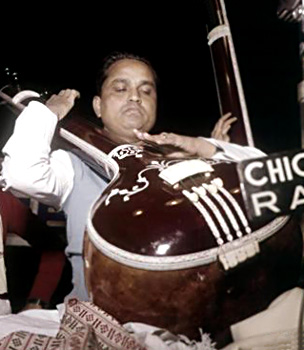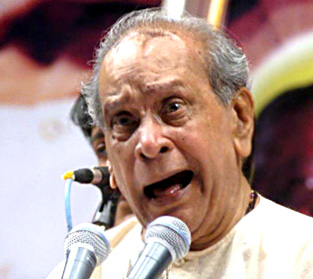 Gharanas of Khayal refer to the various individual styles of Khayal music which developed within the genre. The steady growth in the practice of the Khayal, which reached a fair maturity in Bade Mohammed Khan, Haddu Khan and Hassu Khan, gave rise firstly to individual styles and then to the followers of the styles, or the Gharanas. When talking about a Ghaarana gaayak, it refers to a style belonging to a particular house of musicians and also compositions, which are identified as the medium for the interpretation of style.
Gharanas of Khayal refer to the various individual styles of Khayal music which developed within the genre. The steady growth in the practice of the Khayal, which reached a fair maturity in Bade Mohammed Khan, Haddu Khan and Hassu Khan, gave rise firstly to individual styles and then to the followers of the styles, or the Gharanas. When talking about a Ghaarana gaayak, it refers to a style belonging to a particular house of musicians and also compositions, which are identified as the medium for the interpretation of style.
In the period immediately following its two greatest exponents, Haddu Khan and Hassu Khan, Hindustani Music produced some of the finest musicians in Khayal. They had their own distinctive styles that attracted several disciples and a also found a following in the listening public. There were many princely states, small and not so small, which maintained a few musicians, vocalists and instrumentalists. And musicians attached to or having been born and brought up and residing in the place or region identified themselves as the musician-Gharana of the place. Thus, there are a number of different gharanas such as the Agra Gharana, Sikandrabad Gharana, Delhi Gharana, Jaipur Gharana, Kirana Gharana, Patiala Gharana, etc. Some of the Gharanas are also named after their originators or innovators, like Alladia Khan-Ka-Gharana, Amanali Khan-Ka-Gharana (also called Bhendi Bazar Gharana), Tanras Khan Ka-Gharana, etc.
 Pandit Bhimsen Joshi The respect for the parentage and lineage was rightly earned by the descendants and pupils of the professional gharanedara musicians. In modern times, only those gharanas have survived with which the names of the modern masters of music are associated. Most prominent amongst these are: the Gwalior Gharana, the Agra Gharana, the Kirana Gharana, the Jaipur-Atrauli gharana (alias Jaipur alias Alladia Khan) the Patiala Gharana, and the Rampur Gharana. Long tradition and distinctive style are also claimed by the living musicians of the Sahaswan, Sham-Chaurasi, Jaipur, Khurja, Delhi, and some other Gharanas but their technical and formal affinities with one or the other more known Gharana, at least at present, are such that their distinctiveness centres merely around a few bandishes of special charm.
Pandit Bhimsen Joshi The respect for the parentage and lineage was rightly earned by the descendants and pupils of the professional gharanedara musicians. In modern times, only those gharanas have survived with which the names of the modern masters of music are associated. Most prominent amongst these are: the Gwalior Gharana, the Agra Gharana, the Kirana Gharana, the Jaipur-Atrauli gharana (alias Jaipur alias Alladia Khan) the Patiala Gharana, and the Rampur Gharana. Long tradition and distinctive style are also claimed by the living musicians of the Sahaswan, Sham-Chaurasi, Jaipur, Khurja, Delhi, and some other Gharanas but their technical and formal affinities with one or the other more known Gharana, at least at present, are such that their distinctiveness centres merely around a few bandishes of special charm.
In the modern day and age, the Gharana styles have been undergoing changes, some subtle and some rather conspicuous. These changes have been the outcome of easier communication, i.e. the result of quick transmission through the channels of travel, press, gramophone, the radio and the television. In the case of a true artiste, there is always the inner urge for creativity, to give a new shape to his art and seek a new identity. So, even within the confines of Gharanas and tradition, the modern age has produced, off the centre artistes like Amir Khan and Pandit Bhimsen Joshi in the Kirana Gharana, Pt. Kumar Gandharva in the Gwalior style, and Kishori Amonkar. Innovation and assimilation have been the hallmarks of these artists.




















